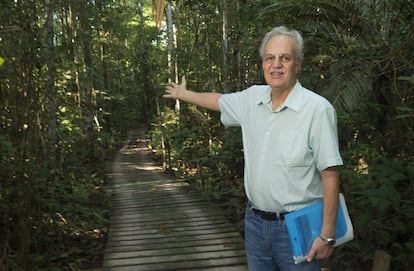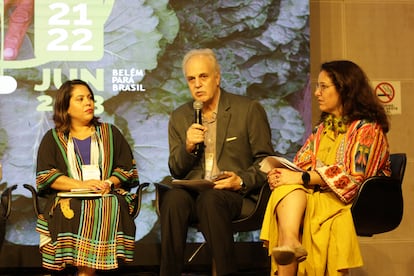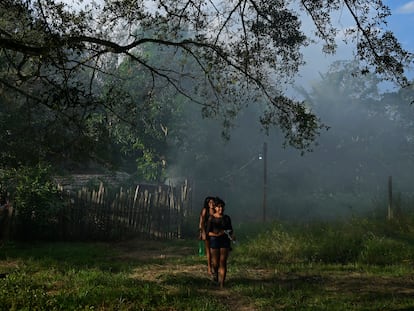Carlos Nobre, Brazilian scientist: ‘The economic potential of the standing forests in the Amazon is greater than agriculture’
One of the most renowned scientists in the region, he insists that this jungle is close to a point of no return. However, he highlights the potential for its conservation


Despite the fact that his mind stores all the data related to what could go wrong with the Amazon, Brazilian scientist Carlos Nobre says that he feels hopeful. The São Paulo-born 72-year-old is one of the most respected experts who have studied this ecosystem. He recently attended the first Pan-Amazon Bioeconomy Conference, which took place in Belém, Brazil. At the meeting, more than 300 Indigenous leaders, members of civil society and local government representatives drafted a series of recommendations on how the Amazon region’s economy should develop. These were then sent to the presidents of Amazonian countries: Brazil, Bolivia, Peru, Ecuador, Colombia, Venezuela, Guyana and Suriname. Nobre says that the conversations surrounding how to achieve a new bioeconomy are what make him optimistic.
The first time Nobre traveled to the Amazon was in 1971. “Of course, at that time, there was almost zero deforestation,” he recalls. “The rivers were magnificent.” By 1975, only 4.5% of its forests had been cleared, meaning that he had the opportunity to see the region in good health, without disturbances. But following that experience more than half-a-century ago, he began to warn the public that the Amazon Rainforest could reach a point of no return. Today, his prediction seems to be coming true.
Question. What do you feel when you see what’s happening to the Amazon?
Answer. I’m very worried. I’ve done a lot of research on this topic. Thirty-three years ago, we published the first scientific article calling attention to deforestation. At that time, the deforestation of only 7% of the Amazon would lead us to the tipping point. And now, unfortunately, it’s not only a projection for the future — we’re at the edge of the tipping point.
We really need to stop forest degradation, immediately. And that’s the idea of this conference: how to maintain the forest and how to improve the livelihoods of the entire Amazonian population. We have to create a new economy — we call it the “standing forest economy.”
Q. You’re the first author of a recent study on how the bioeconomy is key to the Brazilian Amazon. What conclusions did you reach?
A. The study looks at the potential of the value chains of forest products, [analyzing] more than 40 products. We see that, if we develop these products — instead of developing the standard businesses, like cattle ranching, which has been the main driver of deforestation for 50 years — we’ll be able to sustain the forest. [Additionally], this would generate more than 300,000 more jobs, while tremendously improving the quality of life of the entire Amazonian population. It would also imply the restoration of a very large area — almost one million square kilometers (386,000 square miles) — which also implies removing almost 1,000 million tons of carbon dioxide each year from the atmosphere. This is essential to combat the climate emergency.

Q. How do you explain the bioeconomy to someone who doesn’t understand the concept?
A. The bioeconomy is an economy that has to do with the products [that come from] nature. There are several definitions — we prefer to use the term “standing forest bioeconomy” so that it’s not confused with other bioeconomies, such as agriculture, which are also based on nature.
It’s essential to maintain the forests, [so as to] prevent the Amazon from reaching a point of no return. As I’ve said, we must maintain the forests and restore [the large parts] that we have already degraded.
Q. How can the bioeconomy help us avoid reaching that point of no return?
A. There are two great challenges. One is in the Amazon itself: [we need] zero deforestation, zero degradation and the restoration of degraded areas. But at the same time, we need to meet the Paris Agreement’s targets, because if we lose control of the global climate and we reach a temperature increase of [3.6˚F], this would cause the Amazon Rainforest to disappear. So, we have these two challenges: one local and one global. But if we comply with the Paris Agreement, reach zero deforestation and start this great restoration project [of 386,000 square miles], the growth of a secondary forest would be able to stop the tipping points. Of course, there are a number of scientists who say the southern Amazon has already reached a tipping point… but there’s still a scientific discussion to be had.
Q. Regarding the changes that the Amazon is undergoing, you’ve used the term “savannization.” What does this consist of?
A. In the north and south of the Amazon, we have what are known as tropical savannas. They evolved over 40 million years ago. [These areas have] a monsoon type of climate, with a six-month-long dry season, where many fires are caused by lightning. So, when we talk about the savannization of the Amazon, we mean that — when the point of no return is reached — only 50% of the region would be forest. Maybe 70%, only in the places where a lot of rain continues to fall. The rest — the south, east and the center of the Amazon — would begin to have a climate like that of the savanna, with a dry season [that lasts] six months… [In these conditions], you cannot maintain the forest.
Q. A series of recommendations for the governments of Amazonian countries have emerged from this conference. What would you say to the leaders of these countries if you were in front of them?
A. That it’s urgent to achieve zero deforestation and degradation, although I know that it’s a great challenge, because a lot of [these activities] have to do with organized crime. But that’s why we need governments to apply effective governance. In addition, we must also convince [these leaders] that the economic potential of standing forests — of the bioeconomy — is much greater than that of the agriculture sector as we know it today. Again, this isn’t easy, because the politicians continue to be associated with the current economy, with livestock… We must fight a great battle to convince the governments. We see that there are political speeches — like those by Lula [in Brazil] or Petro [in Colombia] — that are beautiful. But unfortunately, there’s a large group of politicians [in the Amazon region] that are associated with the current economy, including organized crime.
Sign up for our weekly newsletter to get more English-language news coverage from EL PAÍS USA Edition
Tu suscripción se está usando en otro dispositivo
¿Quieres añadir otro usuario a tu suscripción?
Si continúas leyendo en este dispositivo, no se podrá leer en el otro.
FlechaTu suscripción se está usando en otro dispositivo y solo puedes acceder a EL PAÍS desde un dispositivo a la vez.
Si quieres compartir tu cuenta, cambia tu suscripción a la modalidad Premium, así podrás añadir otro usuario. Cada uno accederá con su propia cuenta de email, lo que os permitirá personalizar vuestra experiencia en EL PAÍS.
¿Tienes una suscripción de empresa? Accede aquí para contratar más cuentas.
En el caso de no saber quién está usando tu cuenta, te recomendamos cambiar tu contraseña aquí.
Si decides continuar compartiendo tu cuenta, este mensaje se mostrará en tu dispositivo y en el de la otra persona que está usando tu cuenta de forma indefinida, afectando a tu experiencia de lectura. Puedes consultar aquí los términos y condiciones de la suscripción digital.
More information
Archived In
Últimas noticias
All the effects of gentrification in one corner of Mexico’s Colonia Roma
Palestinian reporter Youmna El Sayed: ‘My family told me I had to choose between being a journalist or a mother’
The new language of the workplace: Knowing how to ask AI questions is more important than using it
Russell Tovey: ‘I was advised many times not to come out, I don’t think there was many people who’d done that — and I feel really proud that I’m one of those that did’
Most viewed
- Christian Louboutin: ‘Young people don’t want to be like their parents. And if their parents wear sneakers, they’re going to look for something else’
- The low-cost creative revolution: How technology is making art accessible to everyone
- US sanctions against jailed cartel leader ‘El Marro’ highlight Mexico’s lack of control over its prisons
- Liset Menéndez de la Prida, neuroscientist: ‘It’s not normal to constantly seek pleasure; it’s important to be bored, to be calm’
- Cartels in Mexico take a leap forward with narco-drones: ‘It is criminal groups that are leading the innovation race’










































